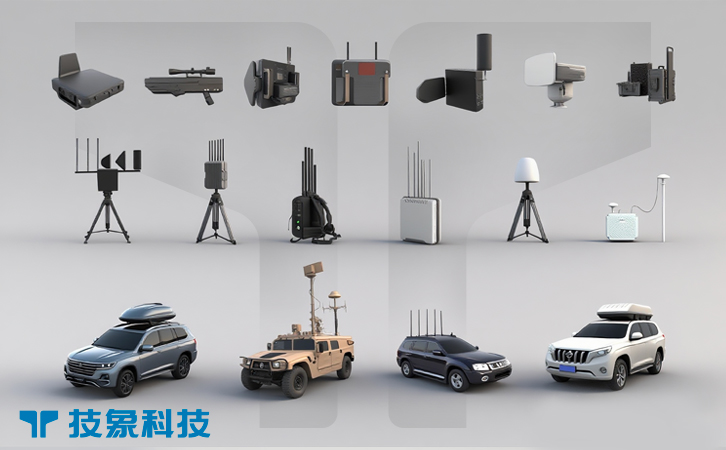The drone proliferation in 2025, with over 6 million UAVs in global use, has made portable counter-drone jammers—backpack and handheld devices that disrupt RF signals—a key technology for mobile defense. These compact systems emit targeted interference to sever drone control links, forcing UAVs to land or return home, ideal for on-the-go scenarios like patrols, events, or urban security where fixed installations are impractical. Unlike vehicle-mounted or high-energy systems, portable jammers offer lightweight, user-friendly disruption, enabling rapid response without heavy infrastructure. This article explores the mobile drone threat, the mechanics of portable jammers, their real-world applications, and the challenges and future potential of this versatile counter-UAV product.
I. The Mobile Drone Threat and Need for Portable Jammers
Rogue drones pose dynamic threats, often appearing suddenly in mobile scenarios like patrols or events, with incidents like unauthorized UAVs over U.S. convoys rising 30% in 2024, leading to operational halts and safety risks. In military contexts, drones shadow moving assets for attacks, as in Ukraine, while civilian risks include pop-up intrusions at festivals or borders, exploiting mobility to evade static defenses.
Fixed jammers lack flexibility for on-the-move use, while kinetics risk debris. Portable jammers fill this gap by providing handheld or backpack disruption, allowing operators to target threats instantly. Their role is crucial for field teams, as seen in 2025 Russian developments of soldier-worn jammers for counter-drone protection. The DEFENSE Act, enacted in September 2025, supports portable tools for local security, emphasizing their importance in countering the agility and unpredictability of drone threats through mobile, immediate intervention.
II. Mechanics of Portable Counter-Drone Jammers
Portable jammers, available as handheld guns or backpack units, emit high-power RF signals on drone frequencies (2.4 GHz, 5.8 GHz, GPS) to overload receivers, disrupting control and navigation. Handheld models like the DroneGun Tactical resemble rifles, with directional antennas for ranges up to 2 km, while backpacks like the Hinaray HN-171018 offer multi-band coverage (6-8 frequencies) for broader disruption.
The mechanics involve aiming the device—often with built-in sights or detectors—and activating the jammer, which can include reactive modes that trigger upon threat detection. AI enhancements in 2025 models, like those from D-Fend Solutions, adapt frequencies in real-time for selective interference. Advantages include portability (under 10 kg for backpacks), battery-powered operation (1-2 hours), and targeted disruption to comply with FCC rules. Limitations include short ranges compared to fixed systems and ineffectiveness against fully autonomous drones. In 2025, innovations like the Russian soldier-worn jammer integrate detection and jamming in compact forms, making portable units a key tactical tool in C-UAS operations.
III. Applications and Real-World Deployments
Portable jammers are deployed in mobile scenarios, offering immediate disruption for field operators. In civilian applications, events like Coachella 2025 used handheld DroneGun Tactical to counter filming drones, ensuring safety without broad interference. Airports equip response teams with backpacks to jam intrusions on the move, as in European trials preventing runway delays.
In military applications, jammers protect patrols and convoys. Russian forces in 2025 developed backpack systems for soldiers to detect and jam drones during advances, enhancing survivability. U.S. border patrols use portable jammers like the Hinaray HN-171018 to disrupt smuggling UAVs in remote areas, capturing them for analysis. The Counter UAS Technology USA Conference in December 2025 showcased these deployments, emphasizing lightweight backpacks for layered defense. Success depends on operator training and integration with detection apps, but their mobility makes them indispensable for dynamic threats.
IV. Challenges and Future Prospects
Portable jammers face regulatory, technical, and ethical challenges. FCC bans on jamming limit civilian use in the U.S., though the September 2025 DEFENSE Act provides exemptions for security teams. Technically, battery life (1-2 hours) restricts prolonged operations, while autonomous drones require broader bands, increasing power needs. Costs start at $10,000 for basic handhelds, escalating for multi-band backpacks.
Ethical concerns include unintended disruption of nearby devices, raising privacy issues, mandating directional designs. International rules like ITU guidelines require selective use to avoid spectrum conflicts. Future prospects are promising, with 2025 innovations in extended batteries and AI-adaptive jamming from companies like DroneShield. By 2030, the counter-UAS market grows, with portables leading for tactical mobility. Policy support ensures ethical deployment, positioning backpack and handheld jammers as a foundation of on-the-go defense.
Conclusion
Portable counter-drone jammers in backpack and handheld forms deliver mobile disruption for rogue UAVs, providing immediate response in 2025’s fast-paced threats. Their targeted interference makes them ideal for events, patrols, and borders, complementing stationary C-UAS tools. Despite challenges like regulations and battery life, real-world successes and emerging innovations highlight their value. As threats evolve, portable jammers—supported by reforms—will remain vital in layered defenses. By overcoming hurdles, stakeholders can equip teams with this technology, ensuring swift protection in a drone-filled world.



